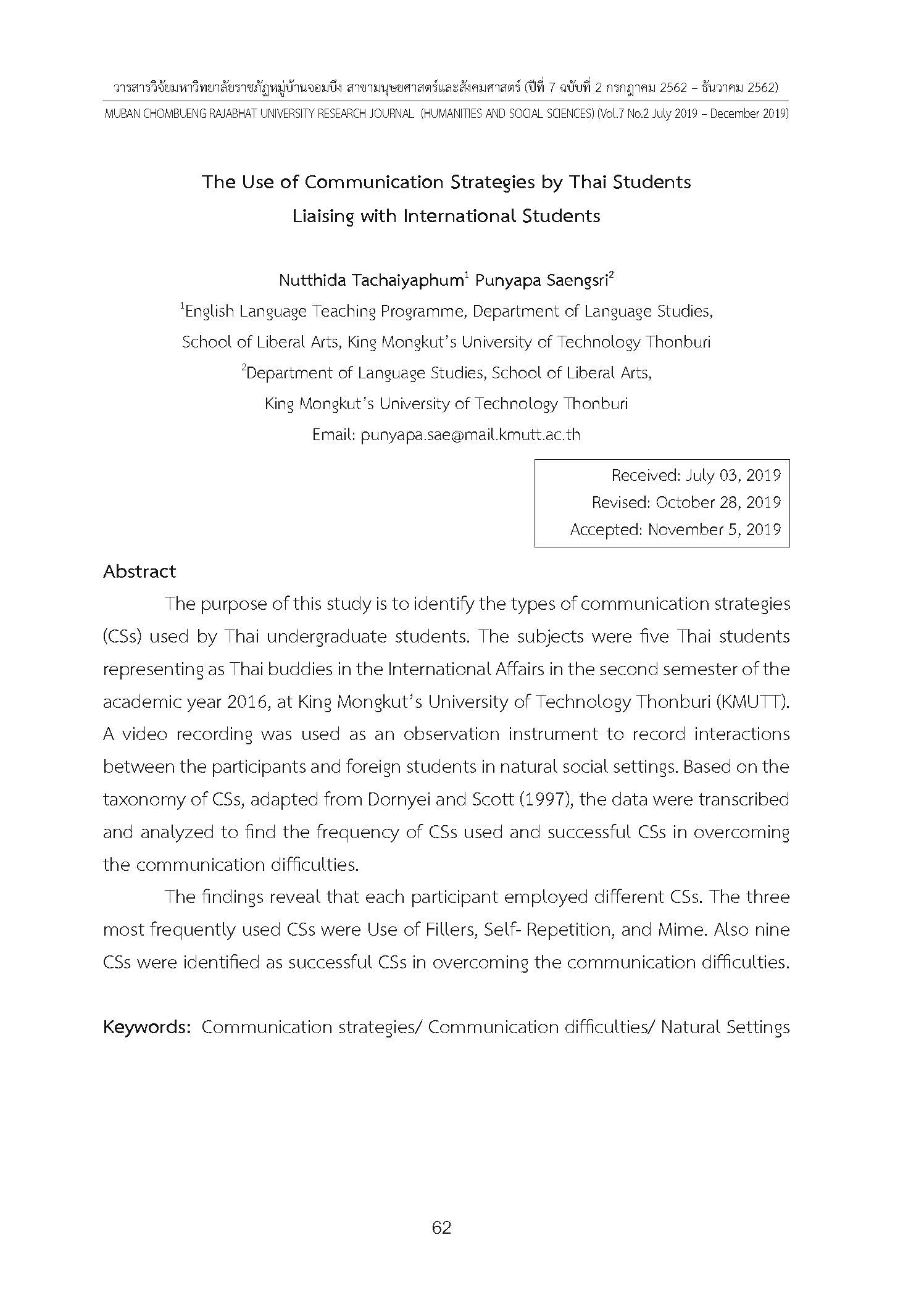-
คำสำคัญ:
-บทคัดย่อ
-
เอกสารอ้างอิง
Abunawas, S., N. (2012). Communication Strategies Used by Jordanian EFL Learners,
Canadian Social Science, 8(40), 187-193.
Charoenchang, W. (1991). An Investigation of Thai Learners and Native-Speaker
Teachers of English Communication Strategies in Classroom Interaction with reference to Two Classroom Contexts: The British Council and KMITT, Master of Arts Thesis, Applied Linguistics for ELT, Department of Language and Social Studies, King Mongkut’s Institute of Technology Thonburi.
Chawana, M. (2009). Communication Strategies Used by Nursing Students when
Interacting with a Foreign Patient in a Nursing Simulation. Master of Arts, Applied Linguistics for ELT, School of Liberal Arts, KMUTT.
Dornyei, Z. & Scott, L. M. (1997). Review Article: Communication Strategies in a Second Language: Definitions and Taxonomies, Language Learning, 47(1), 173-210.
Ellis, R., (1985). Understanding Second Language Acquisition. Oxford: Oxford University Press.
Littlemore, J., (2003). The Communication Effectiveness of Different Types of Communication Strategy. System. 31, 331-347.
Malasit, Y. & Sorobol, N. (2013). Communication Strategies Used by Thai EFL Learners, The 3rd International Conference on Foreign Language Learning and Teaching, Language Institute, Thammasat University.
Maleki, A., (2007). Teachability of Communication Strategies: An Iranian Experience”.
System, 35, 583-594.
Nakatani, Y. (2010). Identifying Strategies That Facilitate EFL Learners’ Oral Communication: A Classroom Study Using Multiple Data Collection Procedures. The Modern Language Journal. 94(1), 116-136.
Nakatani, Y., & Goh, C. (2007). A Review of Oral Communication Strategies: Focus on
Interactionist and Psycholinguistic Perspective, In Language Learning Strategies: Thirty Years of Research and Practice, Cohen, A., & Macaro, E. Oxford: Oxford University Press.
Nyuyen, T., T., & Nguyen, T., K., T. (2016). Oral English Communication Strategies among Vietnamese Non-Majored of English at Intermediate Level. American Journal of Educational Research. 4(3), 283-287.
Pornpibul, N. (2005). Quantitative and Qualitative Views of EFL Learners’ Strategies: A
Focus on Communication Strategies. Journal of English Studies. 2, 64-87.
Selinker, L. (1972). Interlanguage, IRAL; International Review of Applied Linguistics
in Language Teaching, 10(3), 209-230.
Tarone, E. & Yule, G. (1989). Focus on the Language Learner: Approaches to Identify and Meeting the Needs of Second Language Learners.Oxford: Oxford University Press.
Canadian Social Science, 8(40), 187-193.
Charoenchang, W. (1991). An Investigation of Thai Learners and Native-Speaker
Teachers of English Communication Strategies in Classroom Interaction with reference to Two Classroom Contexts: The British Council and KMITT, Master of Arts Thesis, Applied Linguistics for ELT, Department of Language and Social Studies, King Mongkut’s Institute of Technology Thonburi.
Chawana, M. (2009). Communication Strategies Used by Nursing Students when
Interacting with a Foreign Patient in a Nursing Simulation. Master of Arts, Applied Linguistics for ELT, School of Liberal Arts, KMUTT.
Dornyei, Z. & Scott, L. M. (1997). Review Article: Communication Strategies in a Second Language: Definitions and Taxonomies, Language Learning, 47(1), 173-210.
Ellis, R., (1985). Understanding Second Language Acquisition. Oxford: Oxford University Press.
Littlemore, J., (2003). The Communication Effectiveness of Different Types of Communication Strategy. System. 31, 331-347.
Malasit, Y. & Sorobol, N. (2013). Communication Strategies Used by Thai EFL Learners, The 3rd International Conference on Foreign Language Learning and Teaching, Language Institute, Thammasat University.
Maleki, A., (2007). Teachability of Communication Strategies: An Iranian Experience”.
System, 35, 583-594.
Nakatani, Y. (2010). Identifying Strategies That Facilitate EFL Learners’ Oral Communication: A Classroom Study Using Multiple Data Collection Procedures. The Modern Language Journal. 94(1), 116-136.
Nakatani, Y., & Goh, C. (2007). A Review of Oral Communication Strategies: Focus on
Interactionist and Psycholinguistic Perspective, In Language Learning Strategies: Thirty Years of Research and Practice, Cohen, A., & Macaro, E. Oxford: Oxford University Press.
Nyuyen, T., T., & Nguyen, T., K., T. (2016). Oral English Communication Strategies among Vietnamese Non-Majored of English at Intermediate Level. American Journal of Educational Research. 4(3), 283-287.
Pornpibul, N. (2005). Quantitative and Qualitative Views of EFL Learners’ Strategies: A
Focus on Communication Strategies. Journal of English Studies. 2, 64-87.
Selinker, L. (1972). Interlanguage, IRAL; International Review of Applied Linguistics
in Language Teaching, 10(3), 209-230.
Tarone, E. & Yule, G. (1989). Focus on the Language Learner: Approaches to Identify and Meeting the Needs of Second Language Learners.Oxford: Oxford University Press.

ดาวน์โหลด
เผยแพร่แล้ว
2019-12-23
รูปแบบการอ้างอิง
Tachaiyaphum, N. ., & Saengsri, P. . (2019). -. วารสารวิจัยมหาวิทยาลัยราชภัฏหมู่บ้านจอมบึง สาขามนุษยศาสตร์และสังคมศาสตร์, 7(2), 62–80. สืบค้น จาก https://so03.tci-thaijo.org/index.php/hssj/article/view/248236
ฉบับ
ประเภทบทความ
บทความวิจัย
สัญญาอนุญาต
วารสาร TCI อยู่ภายใต้การอนุญาต Creative Commons Attribution-NonCommercial-NoDerivatives 4.0 International (CC BY-NC-ND 4.0) เว้นแต่จะรุบุไว้เป็นอย่างอื่นโปรดอ่านหน้านโยบายของเราสำหรับข้อมูลเพิ่มเติมเกี่ยวกับการเช้าถึงแบบเปิด ลิขสิทธิ์ และการอนุญาต


